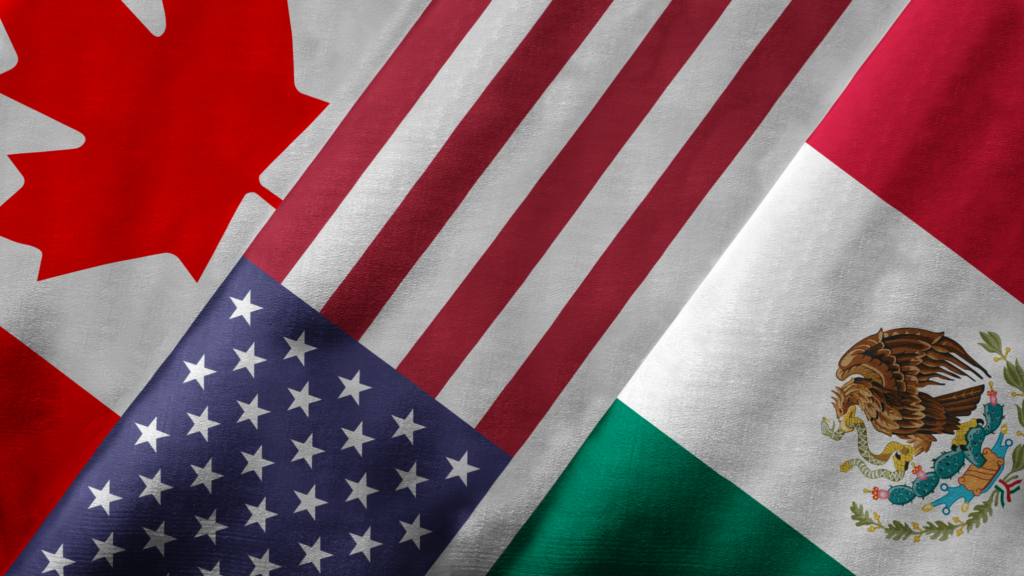
On April 2, 2025, the White House unveiled what it referred to as “Liberation Day,” announcing the most aggressive protectionist policy shift since the 1930s. In a sweeping press conference, President Donald Trump introduced a 10% universal tariff on all U.S. imports, effective April 5, alongside a system of “reciprocal tariffs” targeting approximately 60 countries. Some of these rates are steep—34% on Chinese goods, 24% on Japanese exports, and nearly 50% on products from countries like Cambodia and Vietnam.
Canada and Mexico were notably exempted from these April measures, but not entirely untouched. Earlier in the year, in February 2025, the U.S. had already imposed a separate set of tariffs on Canadian and Mexican imports, citing concerns around border enforcement and drug trafficking. While some of those tariffs were suspended following negotiations, Canada’s position remains vulnerable to shifting geopolitical winds.
For economists, these moves signal a deeper shift in global trade architecture. For Canadian dentists, they represent a new layer of complexity—one that touches everything from the cost of running a clinic to how one invests for the future.
Understanding the broader economic shift
From a macroeconomic standpoint, tariffs function as a tax on international commerce. They raise prices, reconfigure supply chains, and often provoke retaliation. The ripple effects can be far-reaching:
- Supply chains realign: Companies may respond by relocating production to avoid tariffs, creating short-term disruption and longer-term cost implications.
- Inflationary pressures rise: As import costs climb, businesses often pass those costs on to consumers, contributing to price increases across a broad range of goods.
- Central banks face a dilemma: Inflation may rise even as economic growth slows—a combination that could force central banks like the Bank of Canada to choose between rate cuts to stimulate the economy and rate hikes to fight inflation.
Even if Canada is not directly targeted, the nature of global interdependence means we’re likely to feel these effects through supply chains, currency markets, and consumer sentiment.
The business side of dentistry: Practical implications
For Canadian dental professionals, global trade may feel distant—but its effects show up in very real ways.
1. Cost of supplies and equipment
Dental practices rely heavily on imported materials and technology—often from countries now affected by U.S. tariffs. Imaging systems, scanners, sterilizers, and dental chairs frequently originate from the EU, Japan, or Southeast Asia. If manufacturers adjust pricing to compensate for U.S. tariffs, Canadian distributors may follow suit. Some dentists could begin noticing price creep on consumables and capital equipment, or even delays in fulfillment due to logistics shifts.
2. Patient spending behavior
Broader economic uncertainty, particularly when coupled with inflation, can influence discretionary spending. Elective procedures—such as cosmetic dentistry, implants, or Invisalign—are often the first to be deferred when households tighten budgets. Clinics may want to monitor case acceptance trends and be prepared to adjust communication, payment options, or treatment scheduling accordingly.
3. Interest rates and financing strategy
Trade friction typically increases economic uncertainty. In response, central banks sometimes lower interest rates to encourage investment and spending. If the Bank of Canada follows suit, borrowing could become more affordable. For dentists considering real estate purchases, practice expansions, or equipment upgrades, this might offer a window of opportunity. That said, any drop in rates might be accompanied by tighter lending standards, so maintaining clean financials and liquidity will remain important.
Managing investments during a trade-driven market cycle
In volatile periods driven by geopolitics rather than fundamentals, investment strategy often requires fine-tuning. Dentists—like other professionals—should consider how these developments affect their broader financial plans.
For younger dentists
If you’re earlier in your career and still building your net worth, market pullbacks can create long-term opportunities. While volatility can be uncomfortable, it may be a chance to acquire quality assets at reduced valuations. Dollar-cost averaging into diversified portfolios, particularly those with international exposure, could be a way to stay invested without trying to time the market.
For mid-career dentists
This stage often calls for balance. It may be worth taking time to review the diversification within your portfolio—not just across asset classes, but also across geographies. Exposure to sectors more resilient to trade disruptions (e.g., healthcare, infrastructure) might help buffer against economic shocks. A blend of equities, fixed income, and perhaps some alternatives could offer the right mix of growth and risk management.
For dentists nearing or in retirement
If you’re close to retirement, preserving wealth likely becomes the priority. It may be worth asking: “Is my current portfolio still appropriate given this more volatile environment?” A shift toward stable, income-generating assets—like high-quality bonds, dividend-paying stocks, or real estate investment trusts (REITs)—may be worth exploring. For those relying on their portfolio for monthly income, it could also be a good time to assess liquidity needs and ensure access to cash in the event of market dislocations.
Real estate considerations
Interest rates and inflation both influence the real estate market. While higher input costs may place downward pressure on valuations, essential-use commercial real estate, like medical and dental offices, tends to remain relatively resilient. For dentists exploring practice ownership or expansion, the months ahead may offer selective buying opportunities—especially if distressed sellers emerge in overleveraged retail or office sectors.
That said, there’s no need to rush. This may be a time for disciplined observation rather than aggressive action. Running the numbers conservatively, engaging advisors early, and being ready to act when the right opportunity arises could be a more prudent path forward.
Strategic reflections
We are entering a new era of economic nationalism—one that’s unlikely to unwind quickly. Dentists, like all professionals, must adapt to the broader environment they operate in. While much of the conversation around tariffs focuses on manufacturers or exporters, service-based businesses like dentistry are not insulated. Supply chains, cost structures, financing, and patient behavior are all influenced by these broader policy shifts.
If there’s one takeaway for dental professionals, it’s this: Be thoughtful. Be flexible. And don’t underestimate the downstream effects of geopolitical events.
Whether you’re a clinic owner managing a team, an associate preparing to purchase your first practice, or a dentist nearing retirement, this is a moment to check in on your financial plan, revalidate your assumptions, and make sure your strategy still fits the world we’re in—not just the one we planned for.
About the author:

Gurtej Varn is a wealth advisor specializing in serving early to mid-career dentists. His firm, White Coat Financial Inc., offers a full suite of services – investments, insurance, mortgages, tax planning, and financial advice. He’s quickly becoming the go-to advisor for dentists across Canada.











